The Blue Flag Programme is an international system for awarding beaches and marinas that meet some strict criteria. More than 3500 beaches throughout the world have been awarded with the Blue Flag, with Greek beaches being one of the most awarded. In Greece, the Blue Flag Programme is supported by the Greek Society for the Protection of Nature, which determines which beaches meet the relevant criteria.
The award of a blue flag beach is based on compliance with 32 strict criteria covering the aspects of environmental education and information, water quality, environmental management, safety and services
Because the program is an indicator of proper management of the beaches and their quality, Cretans have made great efforts for classifying as many beaches in the Blue Flag program, as possible. Most beaches are located on the northern coast of the island, which are the most touristy, but there are some on the south coasts.
The award of a blue flag beach is based on the following criteria.
Environmental Education and Information
- Information about the Blue Flag must be displayed
- Environmental education activities must be offered and promoted to beach users
- Information about bathing water quality must be displayed
- Information relating to local eco-systems and environmental phenomena must be displayed
- A map of the beach indicating different facilities must be displayed
- A code of conduct that reflects appropriate laws governing the use of the beach and surrounding areas must be displayed
Water quality
The beach must fully comply with the water quality sampling and frequency requirements
The beach must fully comply with the standards and requirements for water quality analysis
No industrial, waste-water or sewage-related discharges should affect the beach area
The beach must comply with the Blue Flag requirements for the microbiological parameter faecal coli bacteria (E.coli) and intestinal enterococci/streptococci
The beach must comply with the Blue Flag requirements for the following physical and chemical parameters\
Environmental Management
- The local authority/beach operator should establish a beach management committee
- The local authority/beach operator must comply with all regulations affecting the location and operation of the beach
- The beach must be clean
- Algae vegetation or natural debris should be left on the beach
- Waste disposal bins/containers must be available at the beach in adequate numbers and they must be regularly maintained
- Facilities for the separation of recyclable waste materials should be available at the beach
- An adequate number of toilet or restroom facilities must be provided
- The toilet or restroom facilities must be kept clean
- The toilet or restroom facilities must have controlled sewage disposal
- On the beach there will be no unauthorised camping or driving and no dumping
- Access to the beach by dogs and other domestic animals must be strictly controlled
- All buildings and beach equipment must be properly maintained
- Coral reefs in the vicinity of the beach must be monitored
- A sustainable means of transportation should be promoted in the beach area
Safety and services
- An adequate number of lifeguards and/or lifesaving equipment must be available at the beach
- First aid equipment must be available on the beach
- Emergency plans to cope with pollution risks must be in place
- There must be management of different users and uses of the beach so as to prevent conflicts and accidents
- There must be safety measures in place to protect users of the beach
- A supply of drinking water should be available at the beach
- At least one Blue Flag beach in each municipality must have access and facilities provided for the physically disabled
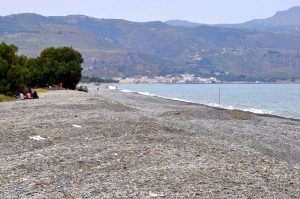
The long beach in Rapaniana is located 20km west of Chania and 4km east of Kolimbari. It is just a part of the vast beach stretching from Cape Rodopos to Chania, including the beaches in front of Skoutelonas, Minothiana and Rapaniana villages.
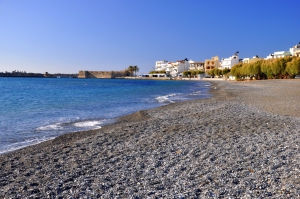
Ierapetra is located 35km southeast of Agios Nikolaos and is the southernmost city of Greece. It is built in one of the warmest areas of Crete, which makes it very popular for holidays, even until the end of autumn. The wider area of Ierapetra is famous for its beaches, stretching along a vast beachfront. Almost all of them are covered by the characteristic fine black pebbles, which do not stick in the leg, and the sea is usually flat.
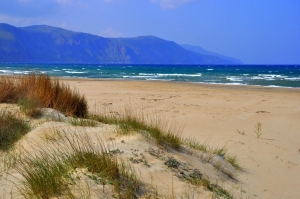
At the point where the prefecture of Rethymno meets Chania, east of Georgioupolis beaches, we find the beaches of Kavros and Kournas. The place at its greatest part is developed and only a very small part of it has been left untouched. Between this remaining virgin parts of the beach there is an extensive and very important ecosystem of dunes.
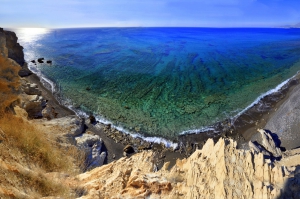
The east end of the long Ierapetra beach is called Livadia, and beyond this, is called Peristeras. This is a secluded area with high cliffs surrounding it. The beach is sandy and has several smooth rocks in places. You can reach the easternmost part of Saint Andrew by walking from the road. However, there is a second sandy beach in Peristeras, just behind the rocky end of the long beach, that can be accessed by the road. This is very well protected by prying eyes, but there are many rocks.
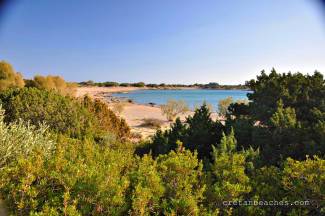
The peninsula of Grammeno(s) is located 85km south of Chania and 5km east of Paleochora, on the road connecting Paleochora with Koudoura. Koudoura is a warm area with greenhouses, where most citizens of the area work.
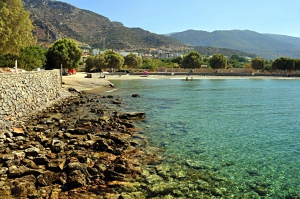
Istro(n) is located 12km east of Agios Nikolaos and 22km north of Ierapetra, very close to Kalo Chorio. It is a quiet village, situated in a lush valley full with olive groves and springs, which has been developed during the last decades. However, the development was fortunately mild, mainly due to the regional building restrictions because of the archaeological discoveries. The main growth driver of Istron is undoubtedly the emerald beaches which are scattered in three adjacent bays.
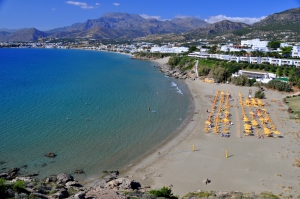
Lagoufa is located right after the east end of Makrigialos main beach, around 59km southeast of Agios Nikolaos and 24km east of Ierapetra. It consists of two adjacent protected coves, which are formed near the big hotels of Makrigialos.
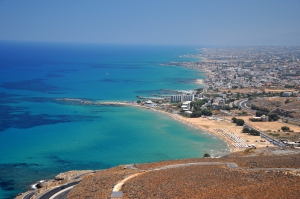
Vathianos River empties in the area, but it gets dry on the summer. The area has several adjacent coves with gold sand and shallow waters. Because the beach front is facing north, waves are quite common. That's why in some places you will see several small piers, breaking the waves.












































































